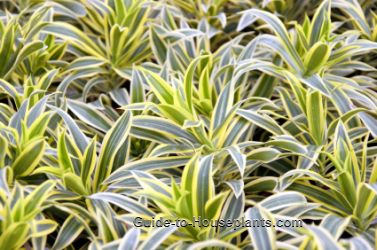Pleomele - Dracaena Reflexa
Dracaena reflexa makes a handsome houseplant. Commonly known as Pleomele or Song of India, this is one of the more decorative types of Dracaena that is grown indoors.
Fortunately for us, it's easy to grow, too. Find out when to water and fertilize, how to head off houseplant problems, plus how to propagate this plant.

Get to Know Dracaena Reflexa Houseplant
Whorls of yellow-banded green leaves spiral upright, reaching about 3 ft (90 cm) tall indoors. Its compact form and slow growth make it an ideal room accent. Give a young plant a boost by placing it on a pedestal plant stand. Those upright rosettes of colorful leaves will look spectacular.
This easy-care plant is native to Madagascar and other islands in the Indian Ocean. Its tropical origins help it to thrive in average room conditions, even tolerating (somewhat) dry indoor air. It will survive in low light, but you'll get the best leaf color and growth by keeping this tropical houseplant in bright, indirect light year-round.
Upright leaves tend to be dust-catchers. Set your plant in the shower and gently spray the leaves with tepid water. Or wipe them off with a damp cloth.
Wondering whether to prune it back? Dracaena reflexa will grow to about 3 ft tall. It rarely branches, so it will eventually become a tall -- sometimes leaning -- houseplant. If your houseplant is getting too tall, you can top it. One of the wonderful things about Dracaenas is that you can cut their stems back anywhere without harming them.
Repot in spring when roots become coiled in the container or grow out of the drainage holes. Use a pot only 1-2 inches (5-8 cm) larger than the old pot because a pot that's too big will hold too much water. Always use fresh potting mix when you repot a plant.
Dracaena Reflexa Problems, Solutions and Answers
Soft stems or yellow leaves? You overwatered. Soggy soil will cause stems to become soft and mushy at the soil level, leaves to turn limp and yellow, and may also cause root rot.
Leaf drop is from potting mix that is either too wet or too dry. (See "Water" tips below.)
Brown leaf tips are often caused by a build up of mineral salts and fluoride. Leaching the potting mix will "clean" it and prevent browning of leaf tips. Here's how: Pour lukewarm water over potting mix and allow it to drain out of the drainage holes. Repeat a couple more times.
Dry, brown patches on leaves are scorch marks caused by hot, direct sunlight. Midday sun can be extremely harsh, especially shining through a window. Place your houseplant where it will receive indirect sunlight.
Something bugging your plant? Dracaena reflexa shrugs off pests, although dry air may attract spider mites to its leaves. Mites are more of a problem in winter, when indoor humidity can drop drastically without our noticing it. Regular misting with water will do double-duty, raising the humidity and keeping those pests away. Scale is another possible pest. Treat any infestation right away.
Is Dracaena poisonous to cats and dogs? Yes, according to the ASPCA, Dracaena spp. contain Saponins, which are toxic. If your pet eats any part of this plant and shows signs of illness, contact your local veterinarian.
Dracaena Reflexa Care Tips
Light: Bright indirect sunlight. You'll get the best leaf color in bright light, but keep the plant out of direct sunlight which can cause brown scorch marks on leaves.
Water: Keep soil lightly moist spring through fall, slightly drier in winter. Do not let soil get waterlogged, which can cause root rot. Dracaenas are sensitive to fluoride, often added to tap water. Use distilled or rainwater. Always use room-temperature water for your indoor plants.
Humidity: Average room (around 40% relative humidity). Indoor air can become extremely dry in the winter without our noticing it. It's a good idea to use a humidity monitor, rather than guess. Here are easy ways to raise the humidity for house plants.
Temperature: Normal room temps (65-75°F/18-24°C) will suit this plant. It tolerates hot better than cold; do not expose it to temperatures below 50°F/10°C. Even cold drafts near a door or window will harm it.
Soil: Good-quality, all-purpose potting mix.
Fertilizer: Feed every 2 weeks in spring and summer with a balanced (such as 10-10-10) water-soluble fertilizer diluted by half.
Propagation: Take 3-4 inch (8-10 cm) stem tip cuttings in spring. Pot 3 in the same container for a fuller effect. Dracaena reflexa cuttings are easy to root in moist sterile potting mix. Keep cuttings warm; for best results use a seedling heat mat to maintain a constant 70°F/21°C temperature day and night until they root.


